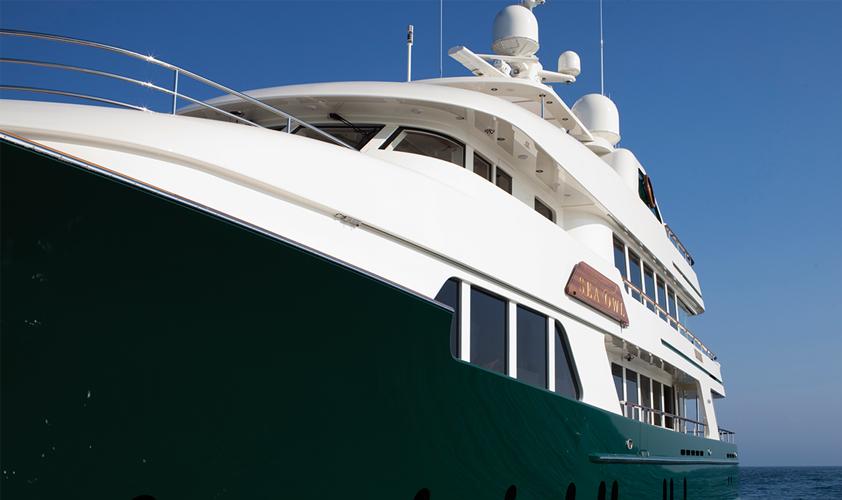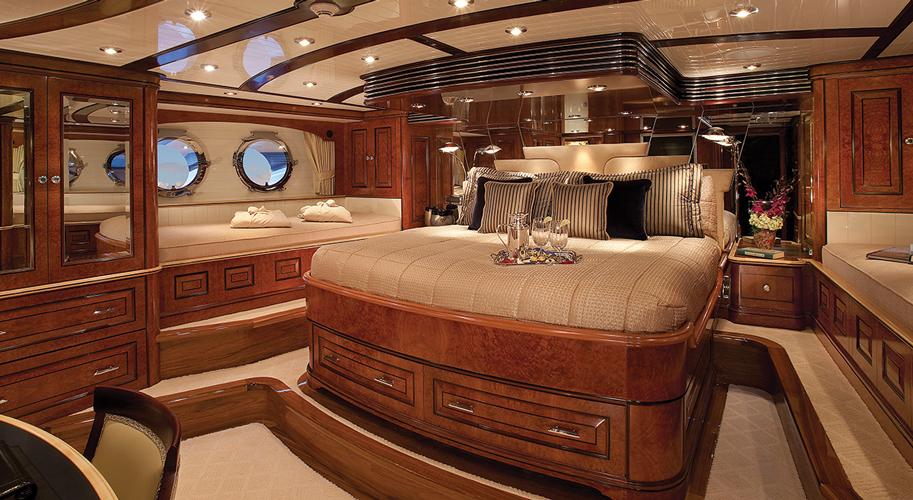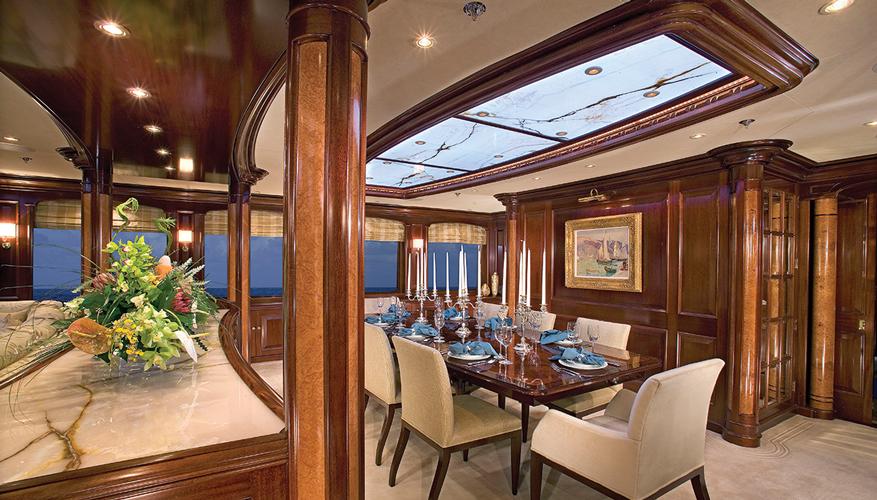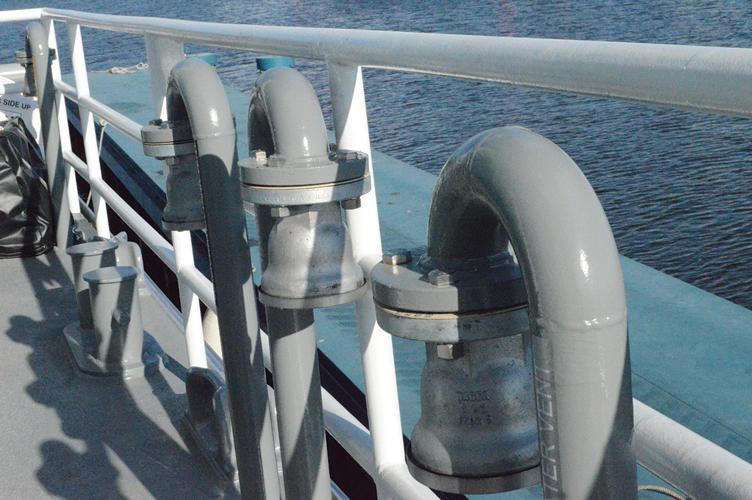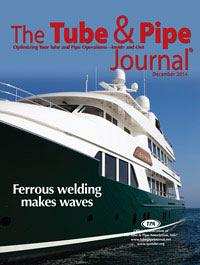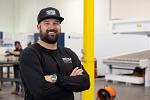- FMA
- The Fabricator
- FABTECH
- Canadian Metalworking
Categories
- Additive Manufacturing
- Aluminum Welding
- Arc Welding
- Assembly and Joining
- Automation and Robotics
- Bending and Forming
- Consumables
- Cutting and Weld Prep
- Electric Vehicles
- En Español
- Finishing
- Hydroforming
- Laser Cutting
- Laser Welding
- Machining
- Manufacturing Software
- Materials Handling
- Metals/Materials
- Oxyfuel Cutting
- Plasma Cutting
- Power Tools
- Punching and Other Holemaking
- Roll Forming
- Safety
- Sawing
- Shearing
- Shop Management
- Testing and Measuring
- Tube and Pipe Fabrication
- Tube and Pipe Production
- Waterjet Cutting
Industry Directory
Webcasts
Podcasts
FAB 40
Advertise
Subscribe
Account Login
Search
Boatbuilder switches from aluminum to steel
A new material means new welding procedures, consumables
- By Eric Lundin
- December 11, 2014
- Article
- Arc Welding
If you’ve ever wondered how you could combine the conveniences of a modern home, the comforts of an upscale hotel, and the freedom to travel the world into a compact and mobile package, wonder no more. The staff at Burger Boat Co., Manitowoc, Wis., do this every day, specializing in luxury yachts and commercial vessels that measure up to 260 feet long.
Burger’s story, which spans more than 150 years, is one of progress and innovation. Founded in 1863 by 24-year-old Henry Burger, the H. Burger Shipyard initially built 20- to 30-ft. boats for the local commercial fishing industry. The company branched out to embrace ship repair, a move that helped it through many lean times in the years ahead.
Burger adopted the gasoline engine around the turn of the century and built U.S. Navy minesweepers, sub chasers, tugs, and rescue boats during World War I. It shifted its focus back to fishing vessels during the Depression years, but it didn’t stop innovating. In the late 1930s it branched out to incorporate new materials and processes, specifically steel and electric arc welding, which positioned it to be a Navy supplier during the next two engagements, World War II and the Korean conflict.
In 1952 Burger was approached by the Reynolds Metals Co. to develop and build vessels made from aluminum. As a result, in 1956 Burger built the first all-welded aluminum vessel in the U.S., the 36-ft. Virginia. In the early 1960s Burger’s production shifted completely to all-welded aluminum construction.
In 2010 Burger won a contract to build an all-welded steel passenger vessel, its first welded steel vessel since 1963. After decades of working almost solely with aluminum, Burger found itself in an unusual situation; it had been so long since it had built a steel vessel that most of its experienced staff had long since retired. Its current metal fabrication and welding staff would need to learn the details of welding ferrous materials.
Starting in the Middle
A luxury yacht is essentially a floating home, so the process of putting one together bears similarities to building a house. After a house is framed, it needs several systems installed, such as plumbing; electrical; and heating, ventilation, and air conditioning (HVAC). It also needs exterior work in the form of windows, siding, and a roof. Each system is accompanied by a hundred details and usually is installed by a subcontractor. Assembling a yacht is a lot like this.
While most fabricators receive repeated orders, meaning they can rely on some consistency from day to day, a boatbuilder’s work isn’t like this. Each vessel is unique in size, shape, and layout, so the fabrication challenges are extraordinary, bringing to mind a quote from Albert Einstein: “Do not worry about your difficulties in mathematics. I assure you that mine are greater.”
“On a boat, nothing is straight and nothing is square,” said Jason Popp, the shop supervisor who oversees metal fabrication and welding at Burger. Some of the contoured items are obvious, like the hull and the keel, which are curved so the boat moves through the water as efficiently as possible, but this is just the beginning. Nearly every surface that appears to be horizontal is actually peaked at the center, sloping both left and right—that is to say, port and starboard—to shed water. In some cases, the deck is highest at the front end of the boat, sloping downward slightly from front to back—fore to aft—for the same reason. Also, because the hull doesn’t have a consistent cross section from fore to aft, the frame sections aren’t consistent in shape or size. Getting everything right, with no rework, takes a supreme effort in planning and execution.
A key component in getting everything right is a stable, level work surface. At Burger, the work takes place on a perfectly level platen that measures 140 ft. long by 35 ft. wide. It consists of dozens of I-beams supported by a multitude of jackscrews. Guided by the extreme precision of a laser, the Burger crew adjusts each jackscrew individually until the platen is perfectly flat.
Some boatbuilders start more or less at the bottom and proceed upward, but at Burger, construction starts in the middle, beginning with the deck and proceeding to the keel. In the early stages, everything is inverted. The deck is laid out upside-down and the bottom section of the vessel takes shape one section at a time until the hull is finished. Meanwhile, another crew fabricates the superstructure (the cabin or wheelhouse). When the hull is complete, cranes lift it and invert it so it’s right-side up. The superstructure then is set onto the hull for final fitting and attachment.
After that step, the various crews spend the next few months installing all of the subsystems: HVAC, plumbing, electrical, and hydraulics. Toward the end, the woodworking department and the outfitting crew add the finishing touches inside and outside, respectively, installing cabinets, furniture, seating, the anchor lifting system, lights, antennas, handrails, and so on.
At this stage some of the work still has similarities to home construction. The electrical work and plumbing are installed more or less as they are in any other residential construction project. However, differences start to arise for the nautical environment and to comply with various marine standards and regulations. For example, some vessels require a fire suppression system and, while PVC pipe has become common in residential plumbing systems, its use is prohibited by some boatbuilding standards. Another key difference is in exhaust and ventilation. On a boat, all ductwork runs to the deck (see Figure 1).
These are the basic construction processes, regardless of the metal used. These didn’t change when the company switched from aluminum to steel, but much else did.
Ferreting out Ferrous Facts
When taking on a new process, especially one concerning welding, fabricators often rely on their vendors’ expertise. Burger Boat is no different. To implement steel fabrication, the company assembled a team that included Pat McGinnis, territory manager for welding gases distributor Praxair; Joe Campbell, senior certified welding inspector (CWI) and owner of WeldTech Solutions Corp.; and three representatives from Burger’s welding consumables supplier, ESAB Welding and Cutting Products: Steven Jackson, account development manager; John Granato, territory sales manager, CWI, and certified welding supervisor (CWS); and Robert Koltz, an applications engineer and CWI.
The first step for the team was an audit of Burger’s hardware. The company had updated its welding power supplies just a few years earlier when it purchased a fleet of 25 modern, solid-state machines. This sort of power supply provides countless possibilities in arc control—waveform shape, the pitch of the leading and trailing edges, pulse settings, crater time, burnback time, and so on. Burger’s old transformer-rectifier type of power supply just provided a set amount of voltage or current, whereas solid-state machines allow the welder to manipulate essentially every aspect of the waveform.
“It’s really a matter of welding with a computer,” Popp said.
Material was the next critical consideration. In this case it was ASTM A36, carbon steel plate intended for structural applications. Burger’s focus wasn’t just on the material, but weld-ready material: It needed a supplier that could provide corrosion-free steel.
“We could purchase raw steel, but we would then have to blast it before we started to work with it, and then we would have to blast it again before we painted it, so we don’t do it that way,” Popp said. “We determined it would make more sense to bring in zinc-coated material,” he said.
Another consideration was finding a supplier that could provide some fabricated components that would complement Burger’s in-house fabrication capability (see Figure 2).
Procedure Development. After evaluating the welding machines, the chemistry of A36, and the role the corrosion-prevention coating would play, the Praxiar-WeldTech-ESAB team worked with Burger to develop the welding procedures based on three ESAB welding consumables.
Campbell’s role was to ensure the processes would result in welds that would comply with the standards and pass the tests designated by the American Bureau of Shipping (ABS) and the American Welding Society (AWS). Campbell’s credentials include AWS certified welding educator (CWE), senior certified welding inspector (SCWI), American Society of Nondestructive Testing (ASNT) Central Certification Program, Visual Testing, Level II, and State of Wisconsin weld test conductor. This expertise, along with more than 25 years in the industry and his service on several AWS technical committees, provided a comprehensive foundation of insight and experience. Although this project represented a sea change at Burger, Campbell noted that the executive staff didn’t shy away from the challenge.
“Burger management did their homework, and they wanted this done properly,” he said. Weld tests can cost several thousand dollars per plate, Campbell said, so it wasn’t an inexpensive undertaking. “Burger has a good reputation, and they didn’t want to soil it,” he said.
For the welds in the early stages, which are long, continuous welds in the flat position, Burger uses a metal-cored wire, Coreweld C6. Although metal-core wire tends to cost more per pound than flux-core wire, management at Burger doesn’t use cost per pound as a guide; it looks at cost per weld. Two critical factors that affect cost per weld are the consumable’s price and welding speed.
“We could use flux-core wire for our flat work, but it would take a lot longer,” Popp said.
“When you’re using metal-core wire, after you get the program dialed in, you can weld much faster. Depending on the parameters, it can be up to twice as fast as flux-core wire,” he said.
The drawback is that metal-core wire is limited to flat and horizontal welding. For the next steps, after the boat starts to take shape, the welders need to do a variety of out-of-position welds. For these, the team recommended Dual Shield 70 Ultra Plus. Intended for low- to medium-carbon steel, it’s an all-position flux-cored wire formulated for a smooth arc and low fume characteristics. When welded with a 75 Ar/25 CO2 mix, its impact strength is rated at 159 J (117 ft.-lbs.) at 0 degrees F as evaluated by the Charpy V-notch test. This is more than enough for this application. The third consumable is OK AristoRod™ 12.50, a bare, solid wire alloyed with manganese and silicon for use on nonalloyed steels used in construction, automotive, pressure vessel, and shipbuilding applications. This was chosen for use in areas where the plate and tube weren’t the heaviest and thickest. According to Popp, all three wires help with a third factor that affects cost per weld, cleanup time.
“These are low-spatter wires, so the welds don’t need a lot of cleanup,” Popp said. “This minimizes the prep time for painting.” This is a big deal on a project that has miles of welds.
Training. McGinnis, Campbell, and Jackson, the main members of the Praxair-WeldTech-ESAB team, concurred that welding aluminum is a great preparation for welding steel.
“Welders who are good with aluminum usually have good work habits, which is a big help when it comes to learning to weld steel,” Campbell said. Aluminum doesn’t allow as much latitude as steel, so welders have to pay closer attention to cleanness, joint preparation, and welding procedures to weld aluminum successfully. The extra preparation and cleanness have to do with aluminum’s ability to conduct both heat and electricity, which is greater than that of steel, Jackson said.
“You have to get everything dialed in just right on the machine, and then you have to pay close attention to how fast you’re welding,” Jackson said. “If you weld too slowly, you can burn right through the base material. If the voltage is set too high, you can burn the filler wire back to the contact tip. The same things happen when welding steel, but they happen more quickly when welding aluminum,” he said.
“Aluminum melts at 1,200 degrees,” McGinnis said. “Welders have to move fast, and they develop excellent hand-eye coordination. When changing to steel, one of the first things we have to teach them is to slow down. If they go too fast, they’ll get ahead of the weld puddle, and this can lead to voids.”
Another factor is the amount the metals expand and contract as the temperature rises and falls, the coefficient of thermal expansion. Steel’s linear rate of thermal expansion is about half that of aluminum.
“Steel has tighter fit-up tolerances,” McGinnis said.
Even though Burger’s welders were being trained on gas metal arc welding (GMAW), the same process they had used on aluminum, switching to steel and learning to use tubular wires, which don’t exist for aluminum GMAW applications, required more than a week of training.
“Even though these are both GMAW processes, they are as different as night and day,” Jackson said.
Despite the challenges, all of the welders became certified, and the project got underway.
Anchors Aweigh!
If it all sounds overwhelming, it isn’t. Burger’s executive team uses some planning strategies it borrowed from the construction industry. After using the vessel drawings to develop a project timeline, the management team creates a timeline in the form of a grid that runs the length of a conference room wall, approximately 5 by 30 ft. (see Figure 3). Each horizontal row represents a trade or system (metals, plumbing, electrical, hydraulics, woodwork, HVAC, and outfitting). Each column represents a week. An executive from each department commits to a timeframe for each step of the construction, and then they look for potential traffic jams. Where they find too many actions crammed into a single week, they spread out the activities to distribute the work more evenly.
It takes a while for it all to come together, but when it does, it’s extremely satisfying. For Burger, the satisfaction isn’t just a matter of building a ship, but building a high-quality ship.
“One of Burger’s main selling points is vessel reliability, which is the best in the industry,” Mitchell said. Recently a tour provider approached Burger to build a passenger vessel for use on the Chicago River. Attracted by Burger’s reputation for quality and reliability, this client contracted Burger to build two new vessels that have been operating reliably since they took delivery. Because the tour company typically runs a dozen tours a day at the height of tourist season, taking a boat out of service for a day or two for a repair would have a substantial financial impact.
“They haven’t missed a single tour with either of their Burger boats,” Mitchell said.
About the Author

Eric Lundin
2135 Point Blvd
Elgin, IL 60123
815-227-8262
Eric Lundin worked on The Tube & Pipe Journal from 2000 to 2022.
About the Publication
Related Companies
subscribe now

The Tube and Pipe Journal became the first magazine dedicated to serving the metal tube and pipe industry in 1990. Today, it remains the only North American publication devoted to this industry, and it has become the most trusted source of information for tube and pipe professionals.
start your free subscription- Stay connected from anywhere

Easily access valuable industry resources now with full access to the digital edition of The Fabricator.

Easily access valuable industry resources now with full access to the digital edition of The Welder.

Easily access valuable industry resources now with full access to the digital edition of The Tube and Pipe Journal.
- Podcasting
- Podcast:
- The Fabricator Podcast
- Published:
- 04/16/2024
- Running Time:
- 63:29
In this episode of The Fabricator Podcast, Caleb Chamberlain, co-founder and CEO of OSH Cut, discusses his company’s...
- Industry Events
16th Annual Safety Conference
- April 30 - May 1, 2024
- Elgin,
Pipe and Tube Conference
- May 21 - 22, 2024
- Omaha, NE
World-Class Roll Forming Workshop
- June 5 - 6, 2024
- Louisville, KY
Advanced Laser Application Workshop
- June 25 - 27, 2024
- Novi, MI
























